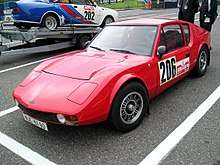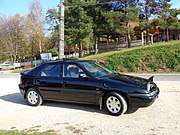Hidden headlamp
Hidden headlamps, also commonly known as pop-up headlamps, pop-up headlights, flip-eye headlamps, hideaway headlights, are a form of automotive lighting and an automotive styling feature that conceals an automobile's headlamps when they are not in use.

Depending on the design, the headlamps may be mounted in a housing that rotates so as to sit flush with the front end as on the Porsche 928, may retract into the hood and/or fenders as on the 1963–2004 Chevrolet Corvette, or may be concealed behind retractable or rotating grille panels as on the Dodge Charger, Mercury Cyclone, or the 1960s Buick Riviera, which pioneered the feature.
History
Hidden headlamps first appeared simultaneously on the Alfa Romeo 8C 2900A Ferrari Berlinetta, car displayed at the Musée National de l'Automobile in Mulhouse, and on the Cord 810 in 1936. Each unit had a crank on its side of the dashboard, which was turned by hand to bring out the headlamps when needed. Electric powered hidden headlamps were pioneered in GM's concept car in 1938, the Buick Y-Job, and first appeared in a production car on Chrysler Corporation's 1942 DeSoto.
The feature's popularity has waxed and waned over time. Hidden headlamps regained popularity in the mid-to-late 1960s, in Europe but particularly in the US where aerodynamic headlamps were not permitted. A relatively large variety of cars incorporated hidden headlamps in the 1970s, 1980s, and up to the early 1990s. Subsequent strict legislation led to hidden headlamps falling increasingly out of favor.
For a long time numerous manufacturers used hidden headlamps to get around the headlight height regulation in the United States; for instance Toyota exported their retractable headlight version of the AE86, known domestically as the Sprinter Trueno, in favour of their Corolla Levin, as the former had higher headlamp height, enough to satisfy US regulations, rather than raise body height, which affected handling.
Discontinuation
US laws now permit aerodynamic headlamps, relative to which hidden headlamps represent added cost, weight, and complexity as well as reliability concerns as cars age. Internationalized ECE auto safety regulations have also recently incorporated pedestrian-protection provisions restricting protuberances from car bodies, making it more difficult and expensive to design compliant pop-up headlamps.
The last time pop-up headlamps appeared on a volume-production car was in 2004 when both the Lotus Esprit and C5 Corvette ended production. Development of both projector beam headlamps — like those on the 1990 Nissan Z — and more efficient, bright LED headlamps of small size will most likely eliminate the need for concealed headlamps altogether, though composite headlamps containing small halogen bulbs offering enough freedom of styling have already replaced them in the mainstream.
List of cars with hidden or pop-up headlights
Production cars
- AC 3000ME, 1979–1984
- Ares Panther, 2018 (redesign of Lamborghini Huracán)
- Acura/Honda Integra DA1/DA2/DA3/DA4/Rover 416, 1986–1989
- Acura/Honda NSX, 1990–2001
- Adams Brothers Probe 15, 1969
- Adams Brothers Probe 16, 1969–1970
- Adams Brothers Probe 2001, 1970–1972
- Alfa Romeo 8C2900A Pininfarina Berlinetta, 1936
- Alfa Romeo Montreal, 1970–1977
- Alpine A610, 1991–1995
- Alpine GTA, 1987 (U.S. spec)
- Aston Martin Lagonda, 1976–1989
- Aston Martin Vantage Zagato Volante, 1986–1989
- Asüna Sunfire, 1993
- Bitter CD & SC, 1973–1979
- Bricklin SV-1, 1974–1976
- BMW 8 Series (E31), 1989–1999
- BMW M1, 1978–1981
- Buick Reatta, 1988–1991
- Buick Riviera, 1965–1969
- Buick SkyHawk, 1986–1989
- Cadillac Eldorado, 1967–1968
- Chevrolet Camaro, 1967–1969 (optional - usually with the Rally Sport model or the RS/SS package)
- Chevrolet Caprice, 1968–1969 (optional and very rare)
- Chevrolet Corvette, 1963–2004
- Chrysler 300, 1968–1971
- Chrysler Imperial, 1969–1993
- Chrysler LeBaron, 1987–1992 (coupe & convertible only)
- Chrysler New Yorker Fifth Avenue, 1990–1993
- Chrysler New Yorker, 1976–1981 and 1988–1993
- Cizeta-Moroder V16T, 1991–2003
- Continental Mark series, 1968–1983
- Cord 810, 1936–1937
- DeSoto, 1942
- De Tomaso Mangusta, 1970–1971 (US-spec)
- De Tomaso Pantera, 1971–1974
- De Tomaso Guarà, 1993–2004
- Dodge Charger, 1966–1970, (optional in 1971 & 1972)
- Dodge Charger Daytona, 1969–1970
- Dodge Daytona, 1987–1991
- Dodge Magnum, 1978–1979 (clear covers)
- Dodge Monaco, 1972–1973
- Dodge Royal Monaco, 1976–1978
- Dodge Stealth, 1991–1993
- Dodge St. Regis, 1979–1981 (clear covers)
- Eagle Talon, 1990–1991
- Ferrari 288 GTO, 1984–1985
- Ferrari 308 GTB, 1975–1984
- Ferrari 328, 1985–1989
- Ferrari 348, 1989–1995
- Ferrari 365 California Spyder, 1966–1967
- Ferrari F355, 1994–1999
- Ferrari F40, 1987–1992
- Ferrari 400/412, 1976–1989
- Ferrari 456/456M, 1992–2003
- Ferrari Berlinetta Boxer, 1973–1984
- Ferrari 365 GTB/4 & GTS/4 "Daytona", 365 GTC/4, 365 GT4 2+2, 1970–1976
- Ferrari GT4, 1974–1980
- Ferrari Mondial, 1980–1995
- Ferrari Testarossa, 512TR, 1984–1994
- Fiat 125 Samantha, 1967 (a two-door coupé version of Fiat 125 built by Vignale and designed by Virginio Vairo)
- Fiat X1/9, 1973–1988 (also called Bertone X1/9 in the USA)
- Ford Capri, 1991–1994 (Third Generation)
- Ford Galaxie 500 XL, 1968–1970
- Ford LTD (Americas), 1968–1970; Landau, 1975–1978 (including Ford Country Squire wagon)
- Ford LTD (Australia), 1973–1976
- Ford Landau, 1973–1976
- Ford Probe, 1989–1997
- Ford Ranchero, 1970–1971 (GT only)
- Ford Thunderbird, 1967–1969, 1977–1982
- Ford Torino Brougham, Cobra, GT 1970–1971
- Geo Storm, 1990–1991
- Ginetta Dare DZ, 1998
- Ginetta G4 Series IV (some models), 1981–1986
- Ginetta G23/24, 1981
- Ginetta G26/31, 1984–1986
- Ginetta G27 (updated version of G4 Series IV), 1986-?
- Ginetta G32, 1989–1992
- Ginetta G33, 1991
- Honda Accord, 1986–1989
- Honda Ballade, 1984–1987
- Honda Prelude, 1983–1991
- Honda Vigor, 1986–1989
- Imperial, 1969–1975 and 1981–1983
- Isdera Imperator 108i, 1991–1993 (facelift model)
- Iso Lele, 1969–1974
- Iso Grifo, 1965–1974
- Isuzu Piazza, 1981–1987 (also Isuzu Impulse, Holden Piazza)
- Jaguar XJ220, 1992–1994
- Kia Elan, 1989–1995 (also sold as Lotus Elan)
- Lamborghini Countach, 1974–1990
- Lamborghini Diablo, 1990–1998
- Lamborghini Islero, 1968–1969
- Lamborghini Jalpa, 1981–1988
- Lamborghini Jarama, 1970–1976
- Lamborghini Urraco, 1973–1979
- Lamborghini Miura, 1966–1973
- Lamborghini Silhouette, 1976–1979
- Lancia Montecarlo, 1975–1979 (for Scorpion, North-American version)
- Lancia Stratos, 1972–1973
- Lincoln Continental, 1970–1979
- Lister Storm, 1993–1999
- Lombardi Grand Prix, 1968–1972
- Lotus Eclat, 1974–1982
- Lotus Elan, 1962–1973 +2 model, 1967–1975
- Lotus Elan M100 1989–1995 (also sold as Kia Elan)
- Lotus Elite, 1974–1982
- Lotus Esprit, 1976–2004
- Lotus Excel, 1982–1992
- Manta Mirage, 1974–1986
- Maserati Bora, 1971–1980
- Maserati Ghibli, 1966–1973
- Maserati Indy, 1969–1974
- Maserati Khamsin, 1974–1982
- Maserati Merak, 1972–1982
- Matra 530, 1967–1973
- Matra Bagheera, 1973–1980
- Matra Murena, 1980–1983
- Mazda 626 (dealer optional with Mazda Cosmo HB front-end for Indonesian market), 1987
- Mazda Cosmo/929 HB coupé, 1981–1989
- Mazda Familia Astina, marketed in Europe as the original 323F, 1989–1994
- Mazda MX-5 Miata (NA), 1989–1997
- Mazda RX-7, 1978–2002
- Mercedes-Benz C111, 1969–1970 (experimental car)
- Mercury Capri, 1991-1994
- Mercury Cougar, 1967–1970
- Mercury Cyclone 1970–1971
- Mercury Marauder, 1969–1970
- Mercury Marquis, 1969–1978
- Mercury Montego, 1970–1971 (some models)
- Mitsubishi GTO/3000GT, 1991–1993
- Mitsubishi Eclipse, 1990–1994
- Mitsubishi Starion, 1982–1990 (also Dodge/Plymouth/Chrysler Conquest, captive imports)
- Monica 560, 1973–1974
- Nissan Silvia/200SX(S12), 1983–1989
- Nissan 180SX/200SX/240SX(S13), 1989–1994 [also 1996–98 (Kouki) 180SX]
- Nissan 300ZX (Z31), 1984–1989
- Nissan Pulsar/N12 NX/N13 NX/N13 EXA, 1983–1990
- Oldsmobile Toronado, 1966–1969 and 1986–1992
- Opel GT, 1968–1973
- Pangra, 1972–1973 (based on Ford Pinto)
- Panther Solo, 1989–1990
- Plymouth Fury, 1970–1971 (Gran Coupe & Sport Fury, Sport Suburban wagon for 1971)
- Plymouth Fury III, 1972 (optional), Gran Coupe & Sport Fury
- Plymouth Laser, 1990–1991
- Plymouth Superbird, 1970
- Pontiac Fiero, 1984–1988
- Pontiac Firebird (including the Trans Am and Formula), 1982–2002
- Pontiac Grand Prix, 1967–1968
- Pontiac GTO, 1968–1969
- Pontiac Sunbird SE/GT 1986–1993
- Porsche 911 Turbo SE 'Slantnose', 1985–1989, 964 Turbo S 'Flatnose', 1994
- Porsche 914, 1969–1976
- Porsche 924, 1976–1988
- Porsche 928, 1978–1995
- Porsche 944, 1982–1991
- Porsche 968, 1991–1994
- Quantum Sports Cars 2+2, 1993
- Reliant Scimitar SS1, 1984–1990
- Reliant Scimitar SST, 1990
- Reliant Scimitar Sabre, 1990–1993
- Saab Sonett III, 1970–1974
- Saturn SC2, 1991–1996
- Subaru XT, 1985–1991
- Siata 208 CS, 1952-1954 (also known as 200 CS)
- Siva S160 Spyder
- Škoda 1100 GT, 1970
- Škoda 110 Super Sport, 1971
- Tatra MTX V8, 1991
- Toyota 2000GT, 1967–1970
- Toyota Celica, 1984–1993
- Toyota Corolla, 1983–1991 (some versions)
- Toyota MR2, 1984–1999
- Toyota Sprinter Trueno, 1983–1992
- Toyota Supra, 1982–1992
- Toyota Tercel, 1982–1988 (also known as Corolla II and Sprinter Carib)
- Triumph TR7/TR8, 1975–1982
- TVR 350i, 350SX, 1983–1989
- TVR 350SE, 1990–1991
- TVR 390SE, 420SE, 1984–1989
- TVR 400SE, 400SX, 430SE, 450SE, 1988–1991
- TVR 420 SEAC, 1986–1988
- TVR 450 SEAC, 1988–1989
- TVR Tasmin, 280i, Tasmin 200, 1980–1988
- Venturi 400 GT
- Venturi Atlantique, 1987–1999[1]
- Venturi Coupé
- Venturi MVS
- Venturi Transcup
- Volvo 480, 1986–1995
- Vector M12, 1995–1999
- Vector W8, 1989–1993
- Zimmer Quicksilver, 1986–1990[2]
Concept cars
- Alfa Romeo Caimano, 1971
- Alfa Romeo Carabo, 1968
- Alfa Romeo Delfino, 1983
- Alfa Romeo Iguana, 1969
- AMC AMX/3, 1970
- Aston Martin Bulldog, 1980
- Autozam AZ-550 Type A, 1989
- BMW 830i/850i Cabrio/M8 (E31)
- BMW GINA, 2008
- Buick Le Sabre, 1951
- Buick Y-Job, 1938
- Chevrolet Aerovette, 1969-1976
- Chevrolet CERVIII, 1990
- Chevrolet Corvair Monza GT, 1962
- Chevrolet Mako Shark, 1962
- Covini B24
- Dome Zero, 1976–1986
- Ferrari 408 4RM, 1987-1988
- Ferrari Rainbow, 1976
- Ford Cobra 230 M.E., 1986
- Ford Probe I, 1979
- Ford Maya
- General Motors XP-819
- Ginetta G25, 1983
- Holden Hurricane, 1969
- Lamborghini Athon, 1980
- Lamborghini Bravo, 1974
- Lamborghini Marco Polo, 1982
- Lamborghini P140, 1987
- Lancia Medusa, 1980
- Lancia Sibilo, 1978
- Lincoln Quicksilver Ghia concept, 1983
- Lotus Etna, 1984
- Lotus M90, 1984
- Mako Shark
- Maserati Boomerang, 1972
- Mazda Miata M Coupe/Roadster, 1997
- Mazda MX-5 (NA) Electric car, 1993
- Mazda P729, 1986
- Mazda V705, 1985
- Mazda MX-81 Aria, 1981
- Mazda RX-7 Concept Model (FD), 1993
- MG EX-E, 1985
- Nissan 126X, 1970
- Nissan MID4, 1985–1987
- Toyota FXV, 1985
- Toyota SA-X, 1981
- Toyota SV-2, 1981
- Toyota SV-3, 1983
- Vauxhall XVR, 1966
- Vector WX-3, 1993
- Volvo Tundra, 1979
- Zender Vision 1S, 1983
- Zender Vision 2, 1985
- Zender Vision 3, 1987
- Zender Vision 3C, 1986
Race cars
Other vehicles with pop-up headlights


- Keisei Electric Railway AE100 (Skyliner), 1990–2016
- Bridgestone Young Way Monte Carlo, 1979[4]
Gallery
.jpg) A 1937 Cord 812
A 1937 Cord 812 A 1938 Buick Y-Job
A 1938 Buick Y-Job- 1968 Chevrolet Caprice sedan.
.jpg) 1942 DeSoto Convertible
1942 DeSoto Convertible A 1967 Ford Thunderbird
A 1967 Ford Thunderbird 1968 Dodge Charger RT
1968 Dodge Charger RT A 1973 SAAB Sonett III
A 1973 SAAB Sonett III

 Škoda 1100 GT
Škoda 1100 GT Mazda 323F 1989
Mazda 323F 1989
See also
References
- Diseno-art.com
- Cars.com
- Honda.co.jp
- Yahoo Archived July 22, 2011, at the Wayback Machine
External links
